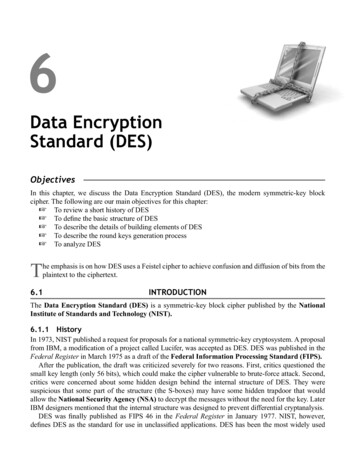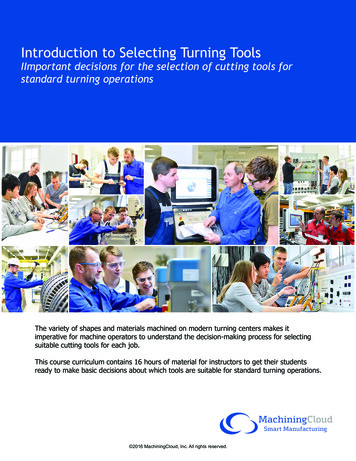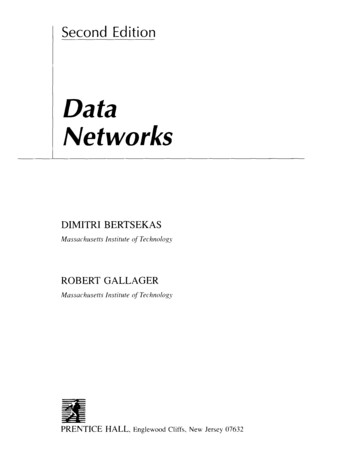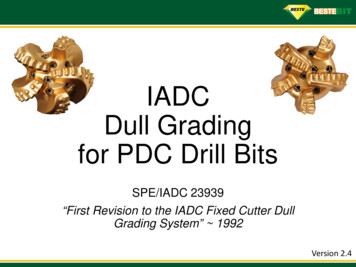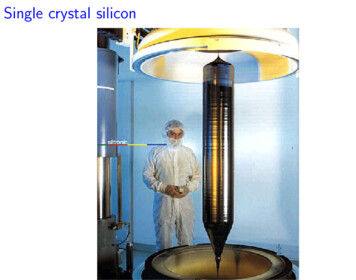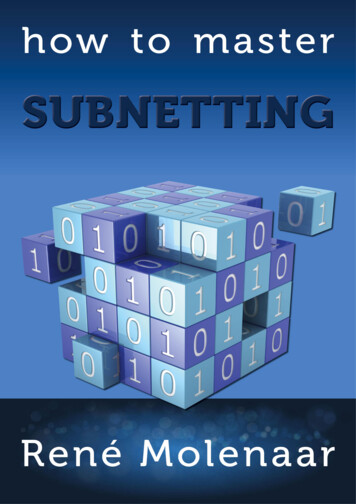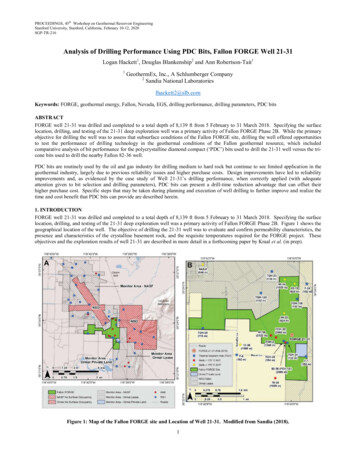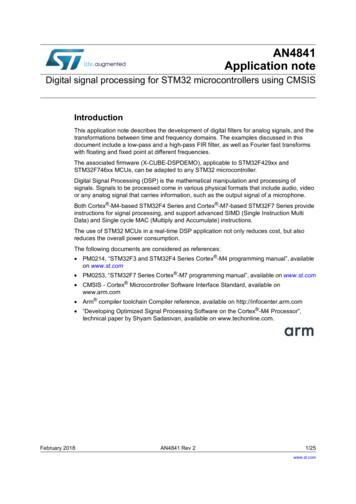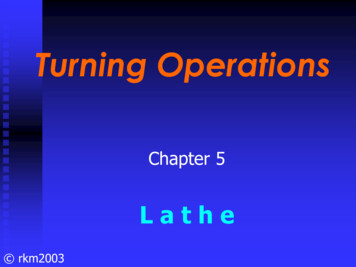
Transcription
Turning OperationsChapter 5Lathe rkm2003
Turning OperationsMachine Tool – LATHEJob (workpiece) – rotary motionTool – linear motions“Mother of Machine Tools “Cylindrical and flat surfaces rkm2003
Some Typical Lathe acing. rkm2003
The LatheH e a d sto c kS p in d leG u id e w a y sT o o l p o stS p in d lesp e e dse le c to rFeed changeg e a rb o xC ro ss slid eD e a d c e n te rT a ilsto c k q u illT a ilsto c kH a n d leC o m p o u n d re sta n d slid e (sw iv e ls)B edC a rria g eA p ro n rkm2003F e e d ro dL e a d sc re w
The LatheHead StockTail StockBedFeed/Lead Screw rkm2003Carriage
Types of LathesEngine LatheSpeed LatheBench LatheTool Room LatheSpecial Purpose LatheGap Bed Lathe rkm2003
Size of LatheWorkpiece Length rkm2003Swing
Size of Lathe .Example: 300 - 1500 LatheMaximum Diameter of Workpiecethat can be machined SWING ( 300 mm)Maximum Length of Workpiecethat can be held betweenCenters ( 1500 mm) rkm2003
Workholding DevicesEquipment used to holdWorkpiece – fixturesTool - jigsSecurely HOLD or Support whilemachining rkm2003
Workholding Devices .ChucksThree jaw rkm2003Four Jaw
Workholding Devices .CentersHeadstock center(Live Centre) rkm2003Tailstock center(Dead Centre)Workpiece
rkm2003WorkpieceWorkholding Devices .Faceplates
rkm2003Workholding Devices .DogsTailTail
Workholding Devices . rkm2003MandrelsWorkpiece (job) with a holeWorkpieceMandrel
Workholding Devices .RestsSteady RestFollower RestJawsWork rkm2003HingeWorkCarriageLathe bed guidewaysJaws
Operating/CuttingConditions1.2.3.Cutting Speed vFeed fDepth of Cut dTool postWorkpieceN (rev/min)ChipTool rkm2003DSperipheralspeed (m/min)
Operating ConditionsTool postWorkpieceChipN (rev/min)SToolperipheralDspeedrelative tool travel in 1 rotation π Dperipheral speed S π D N rkm2003
Operating Conditions.Cutting SpeedD – Diameter (mm)N – Revolutions per Minute (rpm)v π DN1000m/minThe Peripheral Speed ofWorkpiece past the Cutting Tool rkm2003 Cutting Speed
Operating Conditions.Feedf – the distance the tool rkm2003advances for every rotation ofworkpiece (mm/rev)D1D2fFeed
Operating Conditions.Depth of Cutperpendicular distance betweenmachined surface and uncutsurface of the Workpieced (D1 – D2)/2 (mm) rkm2003D1D2d Depthof Cut
3 Operating ConditionsCutting speedW orkpieceDepth of cut (d )M achinedsurfaceNChuck Feed (f )Tool rkm2003ChipDepth of cut
Operating Conditions. rkm2003Selection of .Workpiece MaterialTool MaterialTool signatureSurface FinishAccuracyCapability of Machine Tool
Operations on Lathe .Material Removal RateMRRVolume of material removed in onerevolution MRR π D d f mm3 Job makes N revolutions/min rkm2003MRR π D d f N (mm3/min)In terms of v MRR is given byMRR 1000 v d f (mm3/min)
Operations on Lathe . rkm2003MRRdimensional consistency bysubstituting the unitsMRR: D d f N(mm)(mm)(mm/rev)(rev/min) mm3/min
Operations on Lathe .Operations on Lathe ingTaper turningDrillingThreading
Operations on Lathe . rkm2003TurningCylindrical job
Operations on Lathe .Turning .Cylindrical jobCuttingspeed rkm2003WorkpieceDepth of cut (d)MachinedsurfaceNChuckFeedToolChipDepth of cut
Operations on Lathe .Turning .Excess Material is removedto reduce DiameterCutting Tool: Turning Toola depth of cut of 1 mm willreduce diameter by 2 mm rkm2003
Operations on Lathe .FacingFlat Surface/Reduce lengthChuckWorkpiecedMachinedFaceCuttingspeed rkm2003Depth ofcutToolFeed
Operations on Lathe .Facing .machine end of jobFlat surfaceor to Reduce Length of JobTurning ToolFeed: in direction perpendicular toworkpiece axisLength of Tool Travel radius ofworkpieceDepth of Cut: in direction parallel toworkpiece axis rkm2003
rkm2003Operations on Lathe .Facing .
Operations on Lathe .Eccentric Turning rkm20034-jawchuckAxis of jobAxCuttingspeedEccentric peg(to be turned)
Operations on Lathe . rkm2003KnurlingProduce rough textured surfaceFor Decorative and/orFunctional PurposeKnurling ToolA Forming ProcessMRR 0
Operations on Lathe .KnurlingKnurled surfaceCuttingspeed rkm2003FeedKnurling toolTool postMovementfor depth
rkm2003Operations on Lathe .Knurling .
Operations on Lathe .GroovingProduces a Groove onworkpieceShape of toolshape ofgrooveCarried out using GroovingToolA form toolAlso called Form Turning rkm2003
Operations on Lathe . rkm2003Grooving .Shape producedby form toolForm toolFeed ordepth of cutGrooveGroovingtool
Operations on Lathe .PartingCutting workpiece into TwoSimilar to groovingParting ToolHogging – tool rides over – atslow feedCoolant use rkm2003
Operations on Lathe . rkm2003Parting .Parting toolFeed
Operations on Lathe . rkm2003ChamferingChamferFeedChamfering tool
Operations on Lathe . rkm2003ChamferingBeveling sharp machined edgesSimilar to form turningChamfering tool – 45 ToAvoid Sharp EdgesMake Assembly EasierImprove Aesthetics
Operations on Lathe . rkm2003Taper TurningD D12Taper: tan α 2L90 D1BαALαCD2
Operations on Lathe .Taper Turning.ConicityD1 D2K LMethods rkm2003Form ToolSwiveling Compound RestTaper Turning AttachmentSimultaneous Longitudinal andCross Feeds
Operations on Lathe . rkm2003.By Form ToolTaper TurningWorkpiece TaperαFormStraighttoolcutting edgeDirectionof feed
Operations on Lathe .Taper Turning ,,By Compound Rest rkm2003DogMandrel Tail stock quillTail stockFace plateTool post &Tool holderCross slideDirection of feedCompound restSlideCompound restHand crankα
Operations on Lathe .DrillingDrill – cutting tool – held in TS –feed from TS rkm2003Quillclamp movingDrillquillTail stockFeedTail stock clamp
Operations on Lathe .Process Sequence rkm2003How to make job from rawmaterial 45 long x 30 dia.?1540Steps: Operations Sequence20 dia Tools Process
Operations on Lathe .Process Sequence .Possible SequencesTURNING - FACING - KNURLINGTURNING - KNURLING - FACING XFACING - TURNING - KNURLINGFACING - KNURLING - TURNING XKNURLING - FACING - TURNING XKNURLING - TURNING – FACING XWhat is an Optimal Sequence? rkm2003
Operations on Lathe .Machining TimeTurning TimeJob length Lj mmFeed f mm/revJob speed N rpmf N mm/min rkm2003t Ljf Nmin
Operations on Lathe .Manufacturing TimeManufacturing Time rkm2003 Machining TimeSetup TimeMoving TimeWaiting Time
ExampleA mild steel rod having 50 mmdiameter and 500 mm length isto be turned on a lathe.Determine the machining timeto reduce the rod to 45 mm inone pass when cutting speed is30 m/min and a feed of 0.7mm/rev is used. rkm2003
ExampleGiven data: D 50 mm, Lj 500 mmv 30 m/min, f 0.7 mm/revSubstituting the values of v and D inv π DN1000m/mincalculate the required spindlespeed as: N 191 rpm rkm2003
ExampleCan a machine has speed of191 rpm?Machining time:t Ljf Nmint 500 / (0.7 191) 3.74 minutes rkm2003
ExampleDetermine the angle at which thecompound rest would be swiveledfor cutting a taper on a workpiecehaving a length of 150 mm andoutside diameter 80 mm. Thesmallest diameter on the taperedend of the rod should be 50 mmand the required length of thetapered portion is 80 mm. rkm2003
ExampleGiven data: D1 80 mm, D2 50mm, Lj 80 mm (with usualnotations)tan α (80-50) / 2 80orα 10.620The compound rest should beswiveled at 10.62o rkm2003
ExampleA 150 mm long 12 mm diameterstainless steel rod is to be reducedin diameter to 10 mm by turning ona lathe in one pass. The spindlerotates at 500 rpm, and the tool istraveling at an axial speed of 200mm/min. Calculate the cuttingspeed, material removal rate andthe time required for machining the rkm2003steel rod.
ExampleGiven data: Lj 150 mm, D1 12mm, D2 10 mm, N 500 rpmUsing Equation (1)v π 12 500 / 1000 18.85 m/min.depth of cut d (12 – 10)/2 1mm rkm2003
Examplefeed rate 200 mm/min, we getthe feed f in mm/rev by dividingfeed rate by spindle rpm. That isf 200/500 0.4 mm/revFrom Equation (4),MRR 3.142 12 0.4 1 500 7538.4mm3/minfrom Equation (8), rkm2003 t 150/(0.4 500) 0.75 min.
ExampleCalculate the time required tomachine a workpiece 170 mm long,60 mm diameter to 165 mm long50 mm diameter. The workpiecerotates at 440 rpm, feed is0.3 mm/rev and maximum depth ofcut is 2 mm. Assume totalapproach and overtravel distanceas 5 mm for turning operation. rkm2003
ExampleGiven data: Lj 170 mm, D1 60 mm, D2 50 mm, N 440rpm, f 0.3 mm/rev, d 2 mm,How to calculate the machiningtime when there is more than oneoperation? rkm2003
ExampleTime for Turning:Total length of tool travel job length lengthof approach and overtravelL 170 5 175 mmRequired depth to be cut (60 – 50)/2 5mmSince maximum depth of cut is 2 mm, 5 mmcannot be cut in one pass. Therefore, wecalculate number of cuts or passes required.Number of cuts required 5/2 2.5 or 3(since cuts cannot be a fraction)Machining time for one cut L / (f N)turning time [L / (f N)] Number of Totalrkm2003
ExampleTime for facing:Now, the diameter of the job isreduced to 50 mm. Recall that incase of facing operations, length oftool travel is equal to half thediameter of the job. That is, l 25mm. Substituting in equation 8, wegett 25/(0.3 440) 0.18 min. rkm2003
ExampleTotal time:Total time for machining Timefor Turning Time for Facing 3.97 0.18 4.15 min.The reader should find out the totalmachining time if first facing isdone. rkm2003
Example rkm2003From a raw material of 100 mmlength and 10 mm diameter, acomponent having length 100 mmand diameter 8 mm is to beproduced using a cutting speed of31.41 m/min and a feed rate of 0.7mm/revolution. How many timeswe have to resharpen or regrind, if1000 work-pieces are to beproduced. In the taylor’s expressionuse constants as n 1.2 and C
ExampleGiven D 10 mm , N 1000 rpm,v 31.41 m/minuteFrom Taylor’s tool life expression,we havevT n CSubstituting the values we get,(31.40)(T)1.2 180or T 4.28 min rkm2003
ExampleMachining time/piece L / (f N) 100 / (0.7 1000) 0.142 minute.Machining time for 1000 work-pieces 1000 0.142 142.86 minNumber of resharpenings 142.86/4.28 33.37 or 33 resharpenings rkm2003
Example6:While turning a carbon steelcylinder bar of length 3 m and diameter0.2 m at a feed rate of 0.5mm/revolution with an HSS tool, one ofthe two available cutting speeds is to beselected. These two cutting speeds are100 m/min and 57 m/min. The tool lifecorresponding to the speed of 100m/min is known to be 16 minutes withn 0.5. The cost of machining time,setup time and unproductive timetogether is Rs.1/sec. The cost of one rkm2003tool re-sharpening is Rs.20.
ExampleGiven T1 16 minute, v1 100m/minute, v2 57 m/minute, D 200mm, l 300 mm, f 0.5 mm/revConsider Speed of 100 m/minuteN1 (1000 v) / (π D) (1000 100) / (π 200) 159.2 rpmt1 l / (f N) 3000 / (0.5 159.2) 37.7 minuteTool life corresponding to speed of 100m/minute is 16 minute.Number of resharpening required 37.7 /16 2.35 rkm2003
ExampleTotal cost Machining cost Cost ofresharpening Number ofresharpening 37.7 60 1 20 2 Rs.2302 rkm2003
ExampleConsider Speed of 57 m/minuteUsing Taylor’s expression T2 T1 (v1 / v2)2 with usual notations 16 (100/57)2 49 minuteRepeating the same procedure weget t2 66 minute, number ofreshparpening 1 and total cost Rs. 3980. rkm2003
ExampleWrite the process sequence tobe used for manufacturing thecomponentfrom raw material of 175 mm lengthand 60 mm diameter rkm2003
Example20Threading5040 Dia50405020 Dia rkm2003
ExampleTo write the process sequence, first listthe operations to be performed. Theraw material is having size of 175 mmlength and 60 mm diameter. Thecomponent shown in Figure 5.23 ishaving major diameter of 50 mm, stepdiameter of 40 mm, groove of 20 mmand threading for a length of 50 mm.The total length of job is 160 mm.Hence, the list of operations to be rkm2003carried out on the job are turning,
ExampleA possible sequence for producingthe component would be:Turning (reducing completely to 50mm)Facing (to reduce the length to 160mm)Step turning (reducing from 50 mmto 40 mm)Thread cutting.Grooving rkm2003
rkm2003 Turning Operations Machine Tool – LATHE Job (workpiece) – rotary motion Tool – linear mo
